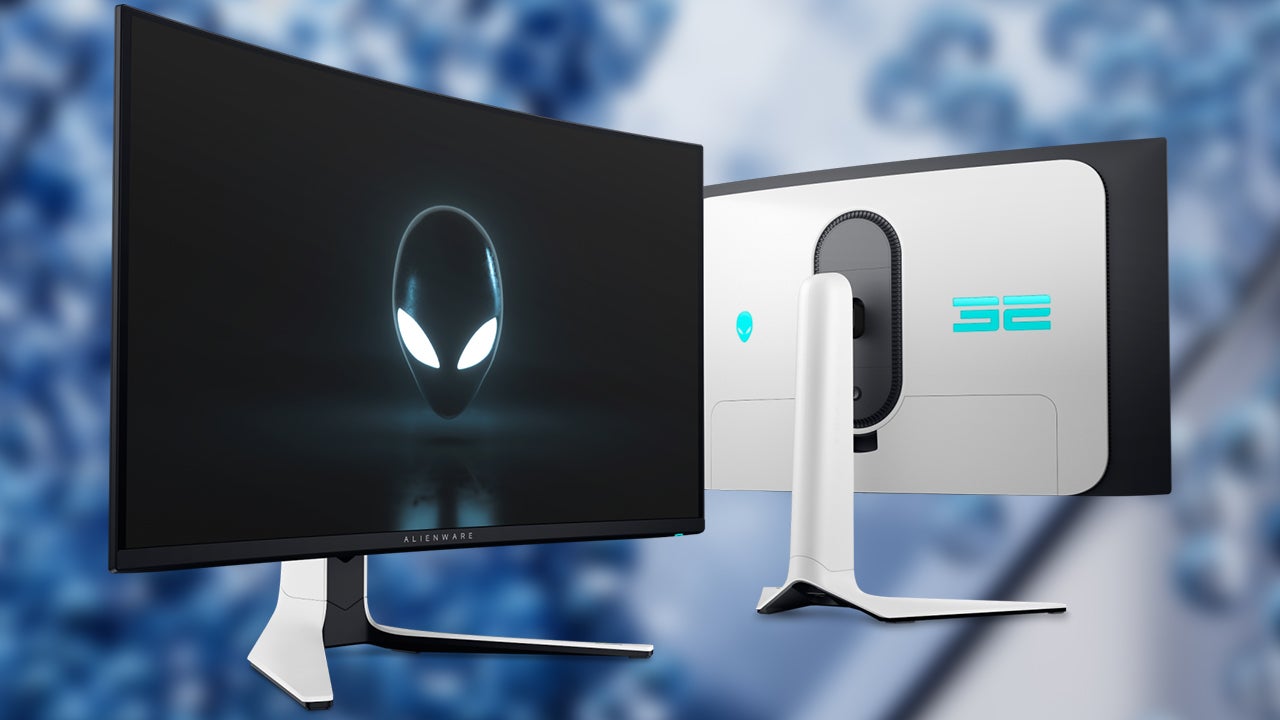A 27-inch gaming monitor with a 1440p resolution and 240Hz refresh rate is a great fit for competitive gamers. The 240Hz refresh rate provides a noticeable boost in motion clarity over a 144Hz alternative, while the 27-inch display provides a more attractive and immersive experience than a tiny 24-inch screen.
There’s just one problem; many 27-inch 240Hz monitors are surprisingly expensive. Alienware’s AW2723DF retails for $649.99, Asus’ ROG Swift PG279QM is $719.99, and Samsung’s 27-inch Odyssey G7 is $499.99. The HP Omen 27qs is a value-minded alternative with an MSRP of just $429.99. It’s not perfect, but it’s a solid choice for gamers who want the motion clarity of 240Hz in a reasonably priced 27-inch monitor.
HP Omen 27qs – Design
HP’s Omen 27qs is a sleek, classy monitor that prioritizes elegance over flash. It has an all-black design that includes a slim, narrow monitor stand with a glossy piano black finish and a (relatively) subtle LED lighting element on the rear panel. The display panel is unobtrusive, too, with extremely slim bezels along the sides and top and a small chin on the bottom. All this adds up to a gaming monitor with a professional look that won’t seem out of place in a home office or living room.
Build quality doesn’t quite live up to the standard set by the monitor’s design. Plastic is the material of choice across all exterior surfaces, including the stand, and some panels feel a tad flimsy. The lack of texture across surfaces is the biggest issue. Careful use of varying textures can make plastics feel more robust but, aside from the piano black inserts along the stand, HP’s choice of material varies little across the monitor.

The stand neck is narrow, as mentioned – too narrow to support VESA mounting. HP instead uses a clip system to attach the stand to the back of the display. The display panel itself does support VESA, but the stand doesn’t. You can attach the monitor to a different stand, but the stand can’t be attached to a different monitor. The stand doesn’t swivel, either, though it can be adjusted for height, tilt, and rotation.
I think HP’s use of a narrow, thin stand allows more wobble than most monitors in this price bracket. It’s not terrible, but I noticed the monitor was prone to shake if I typed harshly or bumped my desk.
HP Omen 27qs – Connectivity & Features
Video connectivity spans two HDMI 2.0 ports and one DisplayPort 1.4 port for a total of three video inputs. Only the DisplayPort 1.4 port will provide the full 240Hz refresh rate at 1440p, however, because HDMI 2.0’s bandwidth is insufficient for 240Hz at 1440p resolution.
The video inputs are joined by a USB-B upstream port which drives two downstream USB-A 3.2 ports. A 3.5mm combo audio jack rounds out the connectivity.
HP’s ports are adequate, but not exceptional. Some competitors, like the Gigabyte M27Q X and NZXT Canvas 27Q, provide a USB-C input in addition to HDMI and DisplayPort. This would’ve been appreciated on the HP Omen 27qs, as its design and branding seems to bridge the gap between hardcore gamers and content creators.

The monitor’s menu system is controlled by an unusual D-Pad style control on the monitor’s right rear flank. It works like a joystick, but the control’s larger surface area makes it easy and comfortable to use. The monitor responds quickly to input, too, so flipping through menus is a breeze.
And there’s a lot to flip through. The monitor provides eight image quality modes, two of which focus on specific color temperature presentation, and a custom color mode with RGB gain adjustment. It also provides several gaming features such as a frame rate monitor, a crosshair, and a “black stretch” feature that lifts the brightness of dark areas to make foes more visible.

The Omen 27qs doesn’t overdeliver in image quality customization, but it hits the mark. Competing monitors from Asus, Acer, Dell, Gigabyte, and other brands tend to provide similar options in this price point.
Speakers are included and, to my surprise, they’re acceptable for casual use. They provide ok volume at maximum and don’t immediately become a muddy, distorted mess. Make no mistake: they’re not great. But if you just want to watch a YouTube video or play a game less focused on audio – like, say Civilization IV – they’re passable.
HP Omen 27qs – Gaming Image Quality
The HP Omen 27qs deliver attractive image quality in games, but its performance depends on the genre and artistic style of the game you’re playing.
I measured a color gamut that spans 100 percent of sRGB, 97 percent of DCI-P3, and 87 percent of AdobeRGB. That’s a solid result for a mid-range gaming monitor and provides a vibrant, alluring presentation in colorful titles like Overwatch 2 or League of Legends. The monitor’s brightness is excellent, as well, reaching a maximum of 376 nits in SDR modes.
With that said, the HP Omen 27qs isn’t without competition. Dell’s less expensive G2724D has a somewhat more narrow color gamut at 86 percent of DCI-P3, but it reaches a higher maximum brightness of 438 nits. The more expensive Cooler Master Tempest GP27Q, meanwhile, exceeds HP Omen 27qs, reaching 96 of DCI-P3 and 100 percent of AdobeRGB while also providing a higher maximum brightness.

While the HP’s color gamut is strong, I must call out an annoying problem: the default “Standard” color mode seems to function as an sRGB mode, which restricts the DCI-P3 color gamut to just 76 percent. This noticeably decreases color saturation and makes for a less attractive experience. Owners who stick to the monitor’s default settings won’t see the monitor’s full potential.
Dark scene performance is mediocre. The HP Omen 27qs reaches a contrast ratio of only 1030:1 and noticeably suffers from “IPS Glow,” the hazy-gray look common to many IPS displays without an active Mini-LED backlight. This problem is acceptable given the HP Omen 27qs’ price, but low pricing on Mini-LED competitors like the Cooler Master Tempest GP27Q places pressure on the HP.
Sharpness is a perk. The HP Omen 27qs is a 27-inch monitor with 1440p resolution, which works out to roughly 109 pixels per inch. That’s significantly less than a 27-inch 4K monitor, which packs 163 pixels per inch. However, the difference is less noticeable than it seems on paper. 4K is the champion of clarity, but 1440p looks crisp in most games.

The HP’s high brightness, solid color gamut, and lackluster contrast make it more suited to fast-paced competitive games than immersive and atmospheric ones. Gamers who prefer Fortnite or DOTA 2 probably won’t find its flaws a significant problem, but those who enjoy Diablo IV or Resident Evil Village will dislike the monitor’s lack of detail in dark, shadowy scenes.
HP Omen 27qs – HDR Image Quality
Fans of games with HDR Support might be tempted by the HP Omen 27qs’ VESA DisplayHDR 400 certification. This is VESA’s lowest level of certification, however, and it’s not enough for a good HDR experience.
The HP Omen 27qs achieved a maximum sustained brightness of 397 nits with HDR turned on. That’s ok, but it’s certainly not enough to deliver the eye-searing luminance HDR is supposed to provide. There’s a distinct lack of detail in bright HDR scenes. Bright areas of the image blend together due to the monitor’s insufficient brightness.
With that said, the monitor does a decent job of handling SDR content in HDR mode. Many budget and mid-range monitors struggle to handle SDR well in HDR mode, which leads to inaccurate colors and a more narrow color gamut. The HP Omen 27qs hardly displayed this issue. The color gamut was similar in SDR and HDR mode when viewing SDR content and the color accuracy was only a hair worse in SDR when HDR was on.
This is a big advantage if you want to use Windows HDR on the Windows desktop. Competitors like the Dell G2724D and Cooler Master Tempest GP27Q have issues handling colors properly in SDR content when HDR is on.
HP Omen 27qs – Motion Performance
The HP Omen 27qs is a 240Hz monitor and promises a minimum gray-to-gray response time of one millisecond. That’s excellent, though typical of many 27-inch monitors that compete with the HP Omen 27qs.
Motion clarity is excellent at 240Hz. Scrolling sample images from League of Leagues and DOTA2 proved that characters and terrain were easy to see. Character names were generally legible, as well, and hitpoint bars were defined enough to be visible, though the individual tick marks that appear in the hitpoint bars were hard to make out.

This is the motion clarity I’ve come to expect from a 240Hz IPS monitor. Most OLED alternatives are a tad more crisp, but an average gamer is unlikely to find the difference significant. And price works to the HP’s advantage. While a few alternatives (such as the Asus TUF Gaming VG27AQML1A) are a bit less expensive, most 27-inch 1440p 240Hz monitors are priced at $500 or above. The HP Omen 27qs delivers a lot of bang-for-your-buck.
HP provides five response times to further tune motion clarity. The default “Level 2 (Fast)” is probably best for most gamers, but Level 3, 4, and 5 provide decreasing response times. They also introduce visible overshoot, a problem that appears as artifacts and halos around moving objects. Level 3 is usable, but Level 4 and Level 5 degrade image quality.
Motion is smooth, too, as the HP Omen 27qs is Nvidia G-Sync compatible. AMD FreeSync Premium Pro also worked alongside a AMD Radeon 6600 video card. I expect other Adaptive Sync solutions will work as well, though I didn’t have a chance to test them.
HP Omen 27qs – Day-to-Day Use
HP’s design suggests the Omen 27qs is a good choice for gamers who need a monitor that also handles day-to-day productivity, or even content creation. The Omen 27qs lives up to that expectation.
The monitor’s 1440p resolution, high maximum brightness, and wide color gamut provide an alluring experience in a wide range of content. Color accuracy is excellent, too, so the monitor can handle photo editing, video editing, and digital art without issue. The only limitation is the monitor’s 1440p resolution which, of course, isn’t high enough to view 4K content at its native resolution. That will be a problem if you want to edit a 4K video.
As mentioned earlier, the monitor has two downstream USB-A ports for connecting wired peripherals and provides built-in speakers. These minor features are provided by many competitors but remain useful for day-to-day use in a home office.
HP Omen 27qs – The Competition
HP’s Omen 27qs faces stiff competition. The market for 27-inch IPS monitors is packed with alternatives from Asus, Acer, Alienware, Dell, Gigabyte, Sceptre, Koouri, Innocn, BenQ, Viewsonic, Pixio, and more.
The NZXT Canvas 27Q remains a favorite pick in this price bracket. Starting at a more affordable $379.99 (with optional stand), the Canvas 27Q is a near exact match for the HP Omen 27’s image quality. It has a less impressive 165Hz refresh rate, however, so competitive gamers may prefer the HP.
Cooler Master’s Tempest GP27Q is an upgrade pick. It provides a Quantum Dot panel and Mini-LED backlight for just $550. Compared to the HP Omen 27qs, the Tempest GP27Q offers a boost in image quality that’s worth the extra cash. However, it’s also a 165HZ monitor.
Samsung’s Odyssey G7 is a more direct alternative. It’s a 27-inch 1440p monitor with a 240Hz refresh rate. However, the Odyssey G7 is a bit more expensive at $499.99 on Amazon. It also has a curved display panel – a polarizing feature some love and others dislike.









